Set Currency Exchange Rates
Set Default Exchange Rates and create unique Exchange Rates for any date range.
/Ofie/Ofie%20Profile%20Pic.png?width=50&height=50&name=Ofie%20Profile%20Pic.png) Important: The Advanced ROI Module and the Multi-Currency Module must be enabled to perform the actions on this support page. If you want to get started with currency conversion, reach out to your Customer Success Manager to enable these modules.
Important: The Advanced ROI Module and the Multi-Currency Module must be enabled to perform the actions on this support page. If you want to get started with currency conversion, reach out to your Customer Success Manager to enable these modules.
Organizations that utilize multiple currencies and advanced Impact reporting have the ability to convert between currencies on Impact Reports. Currency conversion gives you a holistic view of financial data within your organization even when Impacts are recorded in different currencies.
You can define the Exchange Rates used for currency conversion on the Currency Exchange Rates page in the Admin section of KaiNexus. Using this page, you can set the Default Exchange Rates for your organization and make new Exchange Rates for specific time frames, which allows you to use different rates based on when Impacts are realized.
/Currency%20Conversion/Currency%20Exchange%20Rates%20Section.jpeg?width=600&height=454&name=Currency%20Exchange%20Rates%20Section.jpeg) Example of the Currency Exchange Rates page. Note: You must have access to the Admin section to view this page.
Example of the Currency Exchange Rates page. Note: You must have access to the Admin section to view this page.
This support article will discuss setting Exchange Rates for your organization's currencies, including:
/Ofie/Ofie%20Profile%20Pic.png?width=50&height=50&name=Ofie%20Profile%20Pic.png) Pro Tip: Currency conversion is currently available on Impact Reports and is not yet supported on Impact Widgets, Items, or Item Lists.
Pro Tip: Currency conversion is currently available on Impact Reports and is not yet supported on Impact Widgets, Items, or Item Lists.
Who can set Currency Exchange Rates?
Anyone with Quality Administrator included in their System Role Permissions can access the Currency Exchange Rates page, set Default Exchange Rates, create new Exchange Rates, and edit the Exchange Rate Table.
People with other Administrator permissions may be able to access the Currency Exchange Rates page, but will not be able to make changes to it.
Default Exchange Rates
Default Exchange Rates are used to convert financial Impact data between currencies. More specifically, Default Exchange Rates are utilized when there are no rates in the Exchange Rate Table that are applicable for an Impact's date.
/Ofie/Ofie%20Profile%20Pic.png?width=50&height=50&name=Ofie%20Profile%20Pic.png) Important: The Exchange Rate Table allows you to update Exchange Rates over time. For example, if your organization wants to update the Exchange Rates in KaiNexus every quarter or every fiscal year, then you can use the Exchange Rate Table to make new Exchange Rates for specific date ranges.
Important: The Exchange Rate Table allows you to update Exchange Rates over time. For example, if your organization wants to update the Exchange Rates in KaiNexus every quarter or every fiscal year, then you can use the Exchange Rate Table to make new Exchange Rates for specific date ranges.
Default Exchange Rates are used to:
- Convert currencies when there are no Exchange Rates defined in the Exchange Rate Table.
- Convert currencies for Impacts dated before the earliest Start Date defined in the Exchange Rate Table.
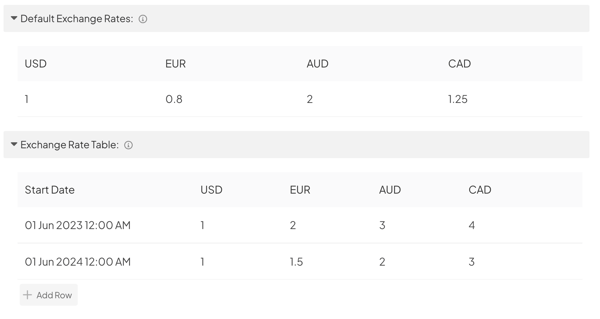
Example of Default Exchange Rates and an Exchange Rate Table. In this example, Impacts realized anytime after June 1st, 2023 will use the rates in the Exchange Rate Table for currency conversion. Impacts realized prior to June 1st, 2023 will use the Default Exchange Rates for currency conversion.
You must have Default Exchange Rates set for your organization to ensure there is always an Exchange Rate available for currency conversion regardless of the date associated with an Impact.
Setting date-specific Exchange Rates in the Exchange Rate Table is optional; however, it is a powerful tool for organizations interested in updating their Exchange Rates in tandem with real-world market conditions.
/Ofie/Ofie%20Profile%20Pic.png?width=50&height=50&name=Ofie%20Profile%20Pic.png) Warning: When you update Default Exchange Rates, the old Default Exchange Rates are not saved. If you want to preserve historical Exchange Rates so that past Impacts use past Exchange Rates, you must log those Exchange Rates in the Exchange Rate Table.
Warning: When you update Default Exchange Rates, the old Default Exchange Rates are not saved. If you want to preserve historical Exchange Rates so that past Impacts use past Exchange Rates, you must log those Exchange Rates in the Exchange Rate Table.
Set Default Exchange Rates
To set the Default Exchange Rates for your organization, navigate to Admin > Organization > Currency Exchange Rates.
Each of your organization's currencies will be listed horizontally beneath the Default Exchange Rates header. The existing Default Exchange Rate will be listed beneath each Currency.
/Currency%20Conversion/Default%20Exchange%20Rate.jpeg?width=688&height=111&name=Default%20Exchange%20Rate.jpeg)
/Ofie/Ofie%20Profile%20Pic.png?width=50&height=50&name=Ofie%20Profile%20Pic.png) Pro Tip: If you need a new currency to be created for your organization, reach out to your Customer Success Manager.
Pro Tip: If you need a new currency to be created for your organization, reach out to your Customer Success Manager.
- By default, the Exchange Rate for each currency will be "1", meaning each currency is valued equally.
- We recommend keeping an Exchange Rate of "1" for your organization's primary currency, which will serve as the reference point for all other Exchange Rates in the platform.
- Exchange Rates for all other currencies should be defined relative to your primary currency. For example, if USD is 1 and EUR is .8, then each US dollar equals .8 Euros. This implies that the US dollar is valued lower than the Euro on the global market.
/Ofie/Ofie%20Profile%20Pic.png?width=50&height=50&name=Ofie%20Profile%20Pic.png) Pro Tip: Using the example Exchange Rates above, the system will apply the following formulas when converting Impact data between Euros and US Dollars:
Pro Tip: Using the example Exchange Rates above, the system will apply the following formulas when converting Impact data between Euros and US Dollars:
Impact logged in Euros ÷ .8 = Impact in USD
Impact logged in USD x .8 = Impact in Euros
To update the Default Exchange Rates:
- Hover over any of the existing Default Exchange Rates. The row will highlight blue.

- Select the Default Exchange Rate you want to update. A number field with the current Exchange Rate already populated will appear.

- Type the new Default Exchange Rate.
- When finished, select Save at the bottom of the page to save your changes.
/Ofie/Ofie%20Profile%20Pic.png?width=50&height=50&name=Ofie%20Profile%20Pic.png) Caution: You must select Save for any updates made on this page to take effect.
Caution: You must select Save for any updates made on this page to take effect.
The Exchange Rate Table
Use the Exchange Rate Table to create Exchange Rates that apply to specific time periods.
Market exchange rates are constantly changing. Making date-specific Exchange Rates allows you to keep up with market fluctuations, ensuring your currency conversions are as accurate as possible. Whether you are updating this table on a weekly, quarterly, or annual basis, you have the freedom to update Exchange Rates as often as you want.
The Exchange Rate Table also serves as a reference point for what Exchange Rates have been in the past. By looking at the Exchange Rate Table, you can tell which Exchange Rates will be used to convert which Impacts.
Here is an example of a simple Exchange Rate Table:
/Currency%20Conversion/Exchange%20Rate%20Table.jpeg?width=688&height=218&name=Exchange%20Rate%20Table.jpeg)
- Each of your organization's currencies will be listed as a column.
- Each row represents a set of Exchange Rates used to convert Impacts in a specific date range from one currency to another.
- The Start Date is the beginning of the date range. The date range ends at the Start Date of the next row.
- In the example image above, Impacts realized in December of 2023 will be converted using the rates in the first row of the Exchange Rate Table. Any Impacts dated after June 1st, 2024 will be converted using the rates in the second row.
- The bottom row of the Exchange Rate Table will not have an end date. All future Impacts will utilize the most recent Exchange Rates until a new row is added.
- Exchange Rates do not have a defined end date until another Exchange Rate is added to the table. When an additional Exchange Rate is added, the start date of the new Exchange Rate becomes the end date of the preceding Exchange Rate.
- Any Impacts preceding the dates in the Exchange Rate Table will use the Default Exchange Rates for currency conversion.
/Ofie/Ofie%20Profile%20Pic.png?width=50&height=50&name=Ofie%20Profile%20Pic.png) Pro Tip: Not all Impacts have a Realized Date. As a result, when the system is determining which Exchange Rate to use during currency conversion, it will reference the date filters on your Report. For example, if you build an Impact Report that includes data from Items Created this year, then the system will use the Exchange Rates active during each Item's Create Date. If you build an Impact Report filtered by Realized Date, then each Impact’s Realized Date will be considered during currency conversion.
Pro Tip: Not all Impacts have a Realized Date. As a result, when the system is determining which Exchange Rate to use during currency conversion, it will reference the date filters on your Report. For example, if you build an Impact Report that includes data from Items Created this year, then the system will use the Exchange Rates active during each Item's Create Date. If you build an Impact Report filtered by Realized Date, then each Impact’s Realized Date will be considered during currency conversion.
Create a new exchange rate
Access the Exchange Rate Table by navigating to Admin > Organization > Currency Exchange Rates.
Select + Add Row to create a new Exchange Rate. A new row in the Exchange Rate Table will be created.

- Use the calendar to set the Start Date for the new Exchange Rate.
/Currency%20Conversion/Currency%20Conversion%20-%20Calendar.jpeg?width=688&height=300&name=Currency%20Conversion%20-%20Calendar.jpeg)
- Select Today if you want the current date to be the Start Date for the Exchange Rates in the new row.
- Hover over the newly added row. It will highlight blue.
/Currency%20Conversion/Exchange%20Rates%20Table%20-%20Highlight.jpeg?width=688&height=255&name=Exchange%20Rates%20Table%20-%20Highlight.jpeg)
- Select the empty space in each currency's column to set an Exchange Rate. A number field will populate.
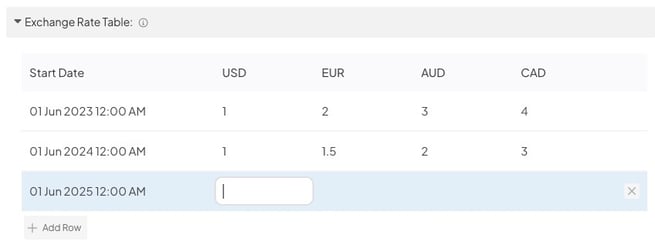
- Enter the new Exchange Rate using your keyboard.
- When finished, select Save at the bottom of the page to save your changes.
- You must enter an Exchange Rate for each currency in the row or you will receive an error message.
/Ofie/Ofie%20Profile%20Pic.png?width=50&height=50&name=Ofie%20Profile%20Pic.png) Pro Tip: When you save the new row, the system will automatically rearrange the rows in chronological order. This ensures the Exchange Rates with a Start Date farthest in the future will always be the last row of the table.
Pro Tip: When you save the new row, the system will automatically rearrange the rows in chronological order. This ensures the Exchange Rates with a Start Date farthest in the future will always be the last row of the table.
Edit the Exchange Rate Table
To edit any rate in the Exchange Rate Table:
- Hover over any of the existing Exchange Rates. The row will highlight blue.

- Select an existing Exchange Rate to update it. A number field with the current Exchange Rate populated will appear.

- Enter the new Exchange Rate using your keyboard.
- Select the Start Date to update it. Use the calendar to select a new Start Date.
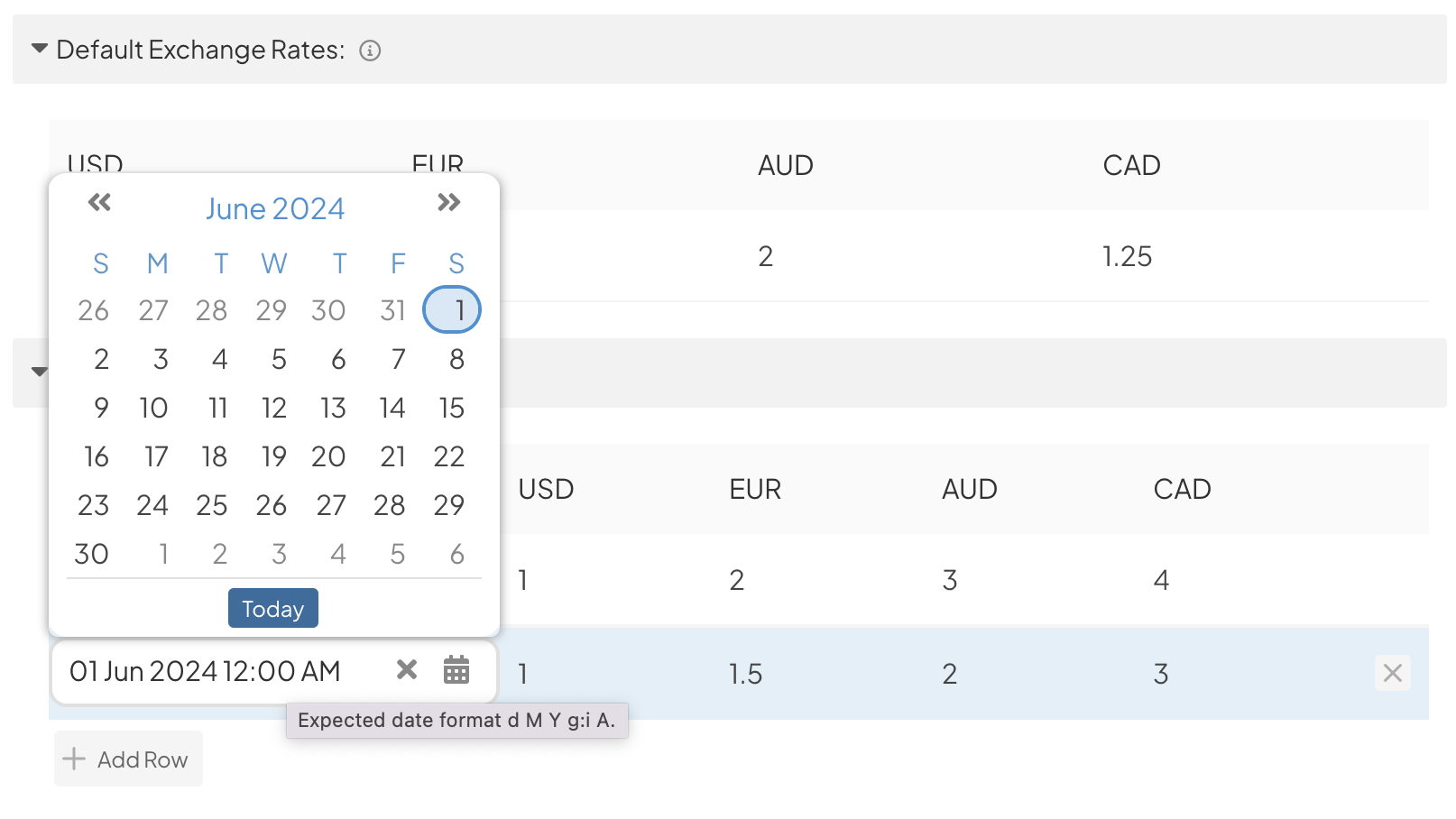
- Select Today if you want the current date to be the Start Date for the Exchange Rates in the selected row.
- When finished editing, select Save at the bottom of the page to save your changes.
Delete an Exchange Rate row
To delete any rate in the Exchange Rate Table:
- Hover over any of the existing Exchange Rates. The row will highlight blue.
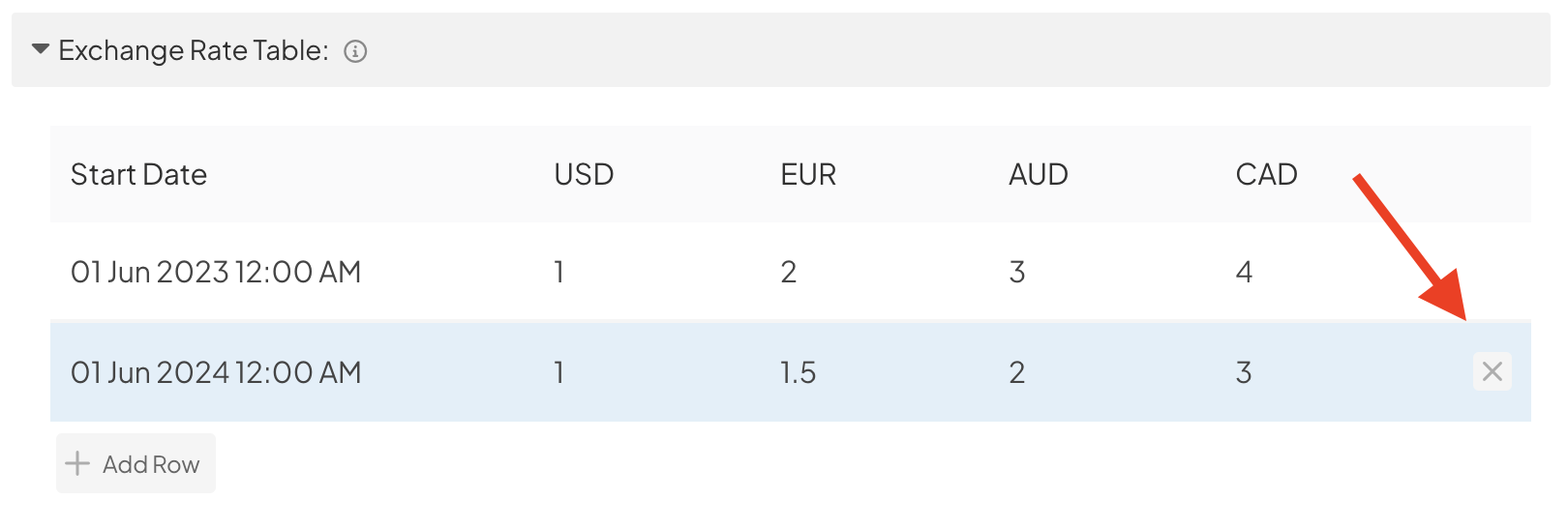
- Select the x icon on the far right of the row.
- In the resulting window, select Delete when asked, "Are you sure you want to delete this exchange rate row?"
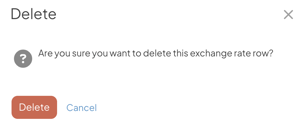
/Ofie/Ofie%20Profile%20Pic.png?width=50&height=50&name=Ofie%20Profile%20Pic.png) Warning: Deleting an Exchange Rate row causes Exchange Rates in that row to be lost, even without selecting Save at the bottom of the page. Any Reports converting currency with the deleted Exchange Rates will use the updated Exchange Rate Table to pick new rates for currency conversion.
Warning: Deleting an Exchange Rate row causes Exchange Rates in that row to be lost, even without selecting Save at the bottom of the page. Any Reports converting currency with the deleted Exchange Rates will use the updated Exchange Rate Table to pick new rates for currency conversion.
Recommended Reading
Now that you know how to set Default Exchange Rates and use the Exchange Rate Table, you can start converting currencies. Check out the Impact Reports below to see where currency conversion is currently available.
- Impact Summary Report
- Impact Over Time Report
- Impact by Location Report
- Impact by Person Report
- Impact by Item Report
- Impact by Impact Value Report